The following is part three of a series of 4 blogs that will go through a white paper written by New Era Converting Machinery’s Bob Pasquale. The white paper is titled “Selecting an Unwind and Unwind Splicer System.”
Part 1 offered an overview of the entire paper and what to expect in coming blogs. Part 2 discussed the holding of the web rolls when unwinding and tension control of the unwinding material. Part 3 continues with the guiding of the web as it exits the unwind, how the end of the expiring roll’s web will be spliced to the beginning of the new roll’s web, and how the expiring roll’s web will be cut. Finally, part 4 will detail the number of unwind positions, offer a comparison of roll to roll versus continuous unwinding, and finish with a brief conclusion.
—–
PART 3: Web Guidance on Exit, Splicing an Expiring Roll to a New Roll’s Web, and Cutting the Expiring Roll’s Web
GUIDING OF THE WEB AS IT EXITS THE UNWIND:
An important consideration is the need to guide the web as it exits the unwind. Though some unwinds are provided without the means of adjusting the web’s cross machine position, most include some form of adjustment. The simplest and most cost effective method is through a manual sidelay system, by which either the roll of web or entire unwind is manually shifted in the cross machine direction. Though this method is inexpensive, it offers no way of precisely adjusting the web’s position nor does it allow for continuous adjustments. To address this many unwinds are provided with automatic closed loop guiding systems, consisting of a method of sensing the web’s position and a method of correcting it. The sensing is typically performed by a single sensor when edge guiding, in which case one edge of the web is aligned to a fixed location, a single sensor for line guiding, in which case a line is provided on the web and the system automatically adjusts to maintain the line in a fixed location, or a pair of sensors when center guiding, in which case the web is maintained evenly between the two sensors, down the center of the machine. These sensors come in many forms including ultra-sonic, infrared and pneumatic, with the selection based on the web materials being processed. The signal from the sensor(s) is interfaced with an actuating device, such as a cylinder or servo driven screw, to adjust the web’s position by moving the unwinding roll or entire unwind in the cross machine direction, or by pivoting a roll or pair of rolls that the web passes over upon exiting the unwind to steer it to the desired position.
HOW THE END OF THE EXPIRING ROLL’S WEB WILL BE SPLICED TO THE BEGINNING OF THE NEW ROLL’S WEB:
One needs to consider how the end of the expiring roll’s web will be joined to the beginning of the new roll’s web. The method of joining is typically dependent on both the web materials and the process that the web is entering. The web material may allow for joining using methods as basic as pressure sensitive tapes or more complex methods such as sewn splices, welded splices or splices formed using a combination of adhesive, heat and pressure. The need for the splice to stand up to process conditions such as moisture, heat and tension can further complicate the splice method selection.
In addition to considering what means is required to hold the web’s together, one needs to consider what type of splice is required. For certain applications a typical lap splice, with the expiring web’s end overlapping the new web’s leading edge, may be sufficient for the webs and process. For other applications, such as a process where the double thickness of web will not make it through the machine (often in areas such as the coater), or a hanging tail that may occur with a lap splice may result in problems, or for a web with a liner that will later be peeled on a continuous basis, a butt splice may be required.
Based on the above considerations, the design of the unwind should include accommodations to allow for the required splice to be formed. This could range from the operator forming a manual zero speed splice on the roll of web, requiring no special hardware, to a simple splice table for forming a manual lap or butt splice (Figure 8), to more complicated and costly splicing arrangements that allow for a dual sided butt splice (Figure 9), integrated sewing machines (Figure 10) or welding equipment (Figure 11).
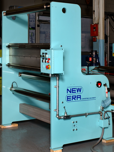
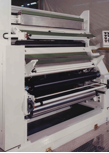
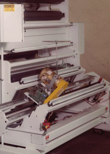
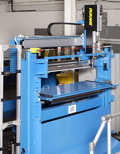
For all of these applications, one needs to consider if the splice can be performed safely and effectively manually or if an automatic system needs to be incorporated.
HOW THE EXPIRING ROLL’S WEB WILL BE CUT:
During normal operation it is typical that one may need to cut the end of the expiring roll’s web, the beginning of the new roll’s web or both as part of the splicing procedure. There are several factors that dictate the method of cutting hardware that is required including the web material that needs to be cut and if the web will be moving or stationary during cutting.
For some applications cutting of the web may be a simple task, performed manually by an operator using a handheld knife or scissors. For such manual operations safety needs to be considered, including requiring that the web be stopped during operator intervention.
For other applications a cutting assembly integrated into the unwind system may be required. In these cases the design of the assembly can vary greatly. For some applications a relatively inexpensive and low maintenance traversing razor (Figure 12) may be suitable. However, this type of cutting mechanism has certain disadvantages including not being able to cut certain materials and, if used with a moving web, the cut may be on a bias. Certain applications may lend themselves to a serrated rupture type blade (Figure 13). This mechanism, which is typically more expensive than the traversing razor, works well at higher speeds but has certain drawbacks including not being able to cut certain materials. For certain applications a shear system (Figure 14) may be most applicable, having the advantage of being able to cut certain difficult to cut materials but having the disadvantages of being costly and somewhat speed limited. For other applications a traversing driven cutter (Figure 15) may be best suited, having the advantage of being able to cut a wide variety of materials but having the disadvantages of being an expensive system to purchase, requiring more maintenance than the other systems, being speed limited and potentially cutting the web on a bias (if the web is moving).
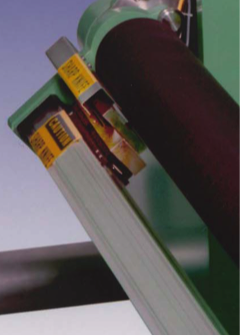
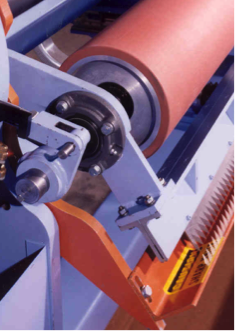
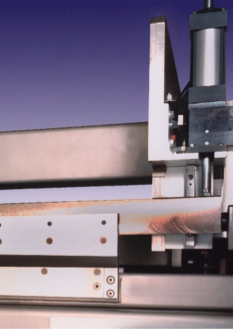
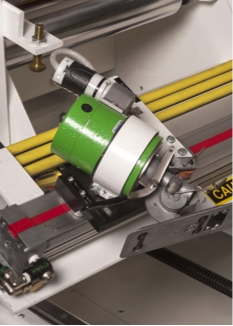
The design of the unwind system must consider the mounting and integration of these assemblies to allow for their safe and seamless operation.
###
*Check back soon for the final blog in the series, or go back and read the first and the second now!*
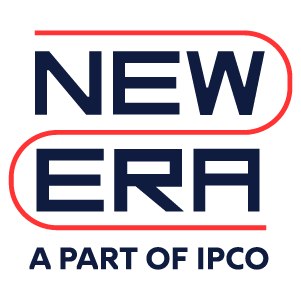












 Downloadable Brochures in PDF Format
Downloadable Brochures in PDF Format